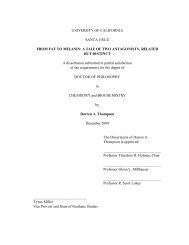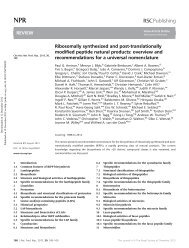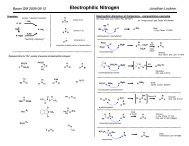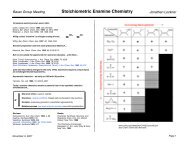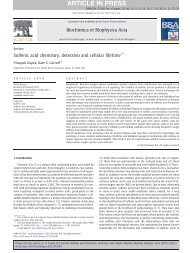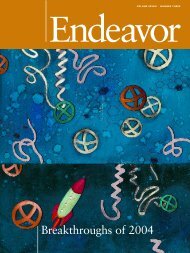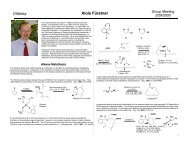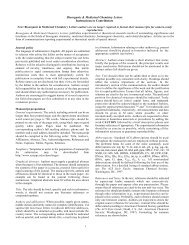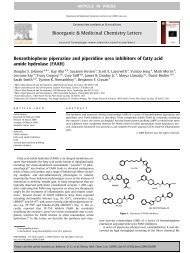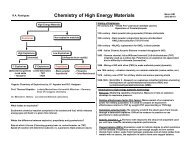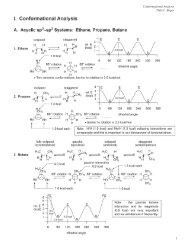The biosynthetic gene cluster for the antitumor drug bleomycin from ...
The biosynthetic gene cluster for the antitumor drug bleomycin from ...
The biosynthetic gene cluster for the antitumor drug bleomycin from ...
You also want an ePaper? Increase the reach of your titles
YUMPU automatically turns print PDFs into web optimized ePapers that Google loves.
Research Paper Bleomycin <strong>biosyn<strong>the</strong>tic</strong> <strong>gene</strong> <strong>cluster</strong> Du et al. 637<br />
<strong>the</strong> epothilone <strong>gene</strong> <strong>cluster</strong> <strong>from</strong> S. cellulosum [11,12] and<br />
<strong>the</strong> myxothiazol <strong>gene</strong> <strong>cluster</strong> <strong>from</strong> Stigmatella aurantiaca<br />
[10] ^ were characterized, and an Ox domain was proposed<br />
by Molnar and co-workers <strong>for</strong> <strong>the</strong> biosyn<strong>the</strong>sis of <strong>the</strong> thiazole<br />
moiety of epothilone [11]. <strong>The</strong> A domain of <strong>the</strong><br />
NRPS-0 module exhibits poor consensus sequence at<br />
A1, A2, A6, A7, and A10 motifs and lacks completely<br />
<strong>the</strong> A3, A4, A5, and A8 motifs (Figure 3A). In addition,<br />
<strong>the</strong> two invariable residues, D in A4 and K in A10 that are<br />
proposed to be essential to interact with <strong>the</strong> K-amino<br />
group and <strong>the</strong> carboxyl group <strong>for</strong> activating an K-amino<br />
acid [18], are mutated into P in A4 and R in A10 <strong>for</strong><br />
<strong>the</strong> NRPS-0 module, respectively. <strong>The</strong>se features strongly<br />
suggests that <strong>the</strong> NRPS-0 A domain is inactive and that<br />
<strong>the</strong> loading of <strong>the</strong> NRPS-0 PCP domain is possibly catalyzed<br />
by <strong>the</strong> A domain of <strong>the</strong> upstream NRPS-1 module.<br />
Inactive domains within PKS modules are known, such as<br />
<strong>the</strong> enoylreductase domain of EPOS A and EPOS E [11]<br />
^ also known as EpoA and EpoF [12]. However, we are<br />
not aware of any inactive domain within an NRPS module<br />
with <strong>the</strong> possible exception of a whole module in <strong>the</strong><br />
exochelin <strong>gene</strong> <strong>cluster</strong> [74,75]. Loading of multiple<br />
PCPs by a single A domain has been proved <strong>for</strong> yersiniabactin<br />
biosyn<strong>the</strong>sis [46,47].<br />
Taken toge<strong>the</strong>r <strong>the</strong> a<strong>for</strong>ementioned structural features of<br />
<strong>the</strong> NRPS-2, -1 and -0 modules and precedence of thiazole<br />
biosyn<strong>the</strong>sis in <strong>the</strong> literature, a <strong>biosyn<strong>the</strong>tic</strong> pathway <strong>for</strong><br />
<strong>the</strong> bithiazole moiety of BLMs could be proposed as<br />
shown in Figure 8C. While it cannot be excluded in <strong>the</strong><br />
absence of any experimental data that <strong>the</strong> single Ox domain<br />
in NRPS-0 module is responsible <strong>for</strong> <strong>the</strong> oxidation of<br />
both thiazole rings, we prefer <strong>the</strong> proposed processive<br />
mechanism of Cys incorporation, cyclization, and oxidation<br />
<strong>for</strong> bithiazole biosyn<strong>the</strong>sis, consistent with <strong>the</strong> lack of an<br />
Ox domain in <strong>the</strong> NRPS-1 module. <strong>The</strong> latter hypo<strong>the</strong>sis<br />
is supported by <strong>the</strong> occurrence of two Ox domains <strong>for</strong><br />
bithiazole biosyn<strong>the</strong>sis observed <strong>from</strong> <strong>the</strong> myxothiazol<br />
<strong>gene</strong> <strong>cluster</strong> [10] and calls <strong>for</strong> an additional oxidase <strong>for</strong><br />
<strong>the</strong> <strong>for</strong>mation of <strong>the</strong> ¢rst thiazole ring in BLM biosyn<strong>the</strong>sis.<br />
A possible candidate <strong>for</strong> this activity would be ORF8<br />
that is highly homologous to coproporphyrinogen III oxidases<br />
[67]. In fact, a cell-free preparation <strong>from</strong> S. verticillus<br />
ATCC15003 has been reported to catalyze <strong>the</strong> conversion<br />
of phleomycins to BLMs in <strong>the</strong> presence of NAD ‡ [27],<br />
supporting <strong>the</strong> presence of a discrete oxidase. We could<br />
imagine that <strong>the</strong> phleomycin producer results <strong>from</strong> a simple<br />
mutation at <strong>the</strong> latter oxidase <strong>gene</strong>, losing its ability to<br />
oxidize <strong>the</strong> ¢rst thiazoline ring.<br />
Be<strong>for</strong>e <strong>the</strong> ¢nal release of <strong>the</strong> BLM peptide^polyketide<br />
backbone <strong>from</strong> <strong>the</strong> BLM megasyn<strong>the</strong>tase, <strong>the</strong> L-position<br />
of <strong>the</strong> His residue is hydroxylated, providing <strong>the</strong> glycosidic<br />
linkage <strong>for</strong> <strong>the</strong> two sugars found in BLMs. Both ORF1,<br />
suggested early by Calcutt and Schmidt in characterizing<br />
<strong>the</strong> blmAB resistance locus [29] and BlmF show signi¢cant<br />
sequence homology to amino acid L-hydroxylases, serving<br />
as candidates <strong>for</strong> catalyzing this hydroxylation. <strong>The</strong> isolation<br />
of both P-6m and P-6mo in <strong>the</strong> <strong>for</strong>m of free carboxylic<br />
acid suggests that L-hydroxylation of <strong>the</strong> His residue takes<br />
place after <strong>the</strong> complete assembly of <strong>the</strong> BLM peptide^<br />
polyketide backbone but be<strong>for</strong>e its release <strong>from</strong> <strong>the</strong> BLM<br />
megasyn<strong>the</strong>tase upon nucleophilic attack by <strong>the</strong> terminal<br />
amines.<br />
Most of <strong>the</strong> NRPSs and PKSs studied to date release <strong>the</strong><br />
full length peptide or polyketide intermediate <strong>from</strong> enzyme<br />
complexes by <strong>the</strong> catalysis of a thioesterase (TE)<br />
domain that is usually found at <strong>the</strong> distal C-terminus of<br />
<strong>the</strong> NRPS or PKS protein [1^3]. <strong>The</strong> BLMs are characterized<br />
by an unique terminal amide moiety, differing structurally<br />
<strong>from</strong> o<strong>the</strong>r well characterized peptide or polyketide<br />
metabolites. Myxothiazol [10] and rifamycin [88] are <strong>the</strong><br />
only two o<strong>the</strong>r peptide and polyketide metabolites with a<br />
terminal amide structure, whose <strong>biosyn<strong>the</strong>tic</strong> <strong>gene</strong> <strong>cluster</strong>s<br />
have been characterized. Although a TE domain is identi-<br />
¢ed at <strong>the</strong> distal C-terminus of <strong>the</strong> proposed Mta NRPS^<br />
PKS hybrid enzyme complex, <strong>the</strong> amino group of myxothiazol<br />
terminal amide is proposed to be derived <strong>from</strong> an<br />
amino acid by <strong>the</strong> action of MtaG, an NRPS module with<br />
an unprecedented monooxygenase domain [10]. <strong>The</strong> latter<br />
domain catalyzes <strong>the</strong> oxidative cleavage at <strong>the</strong> K-position<br />
of <strong>the</strong> last amino acid of <strong>the</strong> full length peptide^polyketide<br />
intermediate to af<strong>for</strong>d <strong>the</strong> terminal amide of myxothiazol,<br />
and this mechanism is proposed to be a <strong>gene</strong>ral strategy <strong>for</strong><br />
<strong>the</strong> <strong>for</strong>mation of terminal amides in o<strong>the</strong>r peptide or polyketide<br />
metabolites [10]. In contrast, <strong>the</strong> Rif PKS <strong>gene</strong><br />
clearly lacks a TE domain. Associated with <strong>the</strong> Rif PKS,<br />
instead, is a discrete protein RifF, an amide synthase [88].<br />
<strong>The</strong> latter enzyme was proposed to catalyze <strong>the</strong> release of<br />
<strong>the</strong> complete polyketide <strong>from</strong> <strong>the</strong> PKS by intramolecular<br />
amide <strong>for</strong>mation to <strong>gene</strong>rate <strong>the</strong> macrocyclic lactam structure<br />
in rifamycin biosyn<strong>the</strong>sis, representing ano<strong>the</strong>r mechanism<br />
<strong>for</strong> <strong>the</strong> amide <strong>for</strong>mation in peptide and polyketide<br />
biosyn<strong>the</strong>sis [88]. <strong>The</strong> <strong>for</strong>mation of <strong>the</strong> amide moiety of<br />
BLMs is apparently distinct <strong>from</strong> both <strong>the</strong> typical peptide<br />
or polyketide biosyn<strong>the</strong>sis and myxothiazol or rifamycin<br />
biosyn<strong>the</strong>sis. Nei<strong>the</strong>r TE domain, unusual NRPS module<br />
with a monooxygenase domain, nor discrete amide synthase<br />
has been identi¢ed within <strong>the</strong> sequenced blm <strong>gene</strong><br />
<strong>cluster</strong>. <strong>The</strong>se ¢ndings, in fact, are consistent with early<br />
feeding experiments that clearly established that various<br />
amines can be incorporated into <strong>the</strong> C-terminal amine moiety<br />
of BLMs [24^27], excluding <strong>the</strong> amino acid origin of<br />
<strong>the</strong> terminal amino group, as has been proposed <strong>for</strong> myxothiazol<br />
biosyn<strong>the</strong>sis [10]. In addition, over 40 different<br />
amines have been incorporated into BLMs by directed<br />
biosyn<strong>the</strong>sis [24^27], suggesting that <strong>the</strong> enzyme activity<br />
responsible <strong>for</strong> <strong>the</strong> amide <strong>for</strong>mation must have exhibited a<br />
very broad substrate speci¢city <strong>for</strong> <strong>the</strong> amine. Interestingly,<br />
£anking <strong>the</strong> modular blm NRPS and PKS <strong>gene</strong>s are two<br />
orfs, blmXI and blmII, whose deduced products are highly



